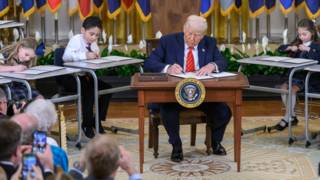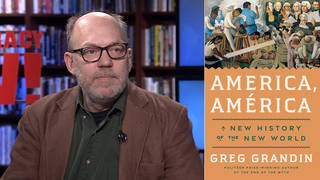
Guests
- Stuart Schraderassociate director of the Program in Racism, Immigration, and Citizenship at Johns Hopkins University.
The American Civil Liberties Union and Black Lives Matter announced Thursday they are suing President Trump and Attorney General William Barr for authorizing an “unprovoked and frankly criminal attack” on protesters at Lafayette Park in Washington, D.C., where the National Guard and officers dressed in riot gear fired tear gas, rubber bullets and flashbangs to disperse peaceful protesters on Monday so Trump could have a photo op with a Bible in front of St. John’s Episcopal Church. We look at the increasing militarization of the police with Stuart Schrader, author of “Badges Without Borders: How Global Counterinsurgency Transformed American Policing.”
Transcript
AMY GOODMAN: As we take this larger, turning from Chris’s story to look at the militarization of the police force, the American Civil Liberties Union and Black Lives Matter announced Thursday they’re suing President Trump and Attorney General William Barr for authorizing a, quote, “unprovoked and frankly criminal attack” on protesters, that in Lafeyette Park in Washington, D.C., where the National Guard and officers dressed in riot gear fired tear gas, rubber bullets and flashbangs to disperse peaceful protesters on Monday so Trump could have his photo taken with a Bible in front of St. John’s Episcopal Church. The bishop there criticized him, said it was completely inappropriate that they should use their church, that Trump should use their church as a backdrop. The lawsuit alleges the Trump administration violated protesters’ constitutional rights of free speech and assembly.
For more, we’re going to Baltimore, Maryland, to speak with Stuart Schrader, associate director of the Program in Racism, Immigration, and Citizenship at Johns Hopkins University, author of the book Badges Without Borders: How Global Counterinsurgency Transformed American Policing.
Welcome back to Democracy Now! Can you talk, Stuart, about this militarization of police?
STUART SCHRADER: Yeah. I think what we’re seeing right now with the protests is a convergence of what I would consider three trends. The first is a long-term trend of police being trained to treat political protest and agitation as almost tantamount to a revolutionary situation, and therefore understanding their job of controlling protest as basically defending the republic. This has a long history. I cover it in my book. It goes back throughout the 20th century. I think we can apply the term “counterinsurgency” to this, meaning that we’re seeing a combination of social and political power being used to control political protest, in addition to police power, even in the absence of a real insurgency or a real revolutionary situation. This is a long-standing trend.
Another trend is what most of us would refer to as the militarization of policing. That means the use of military-style body armor and helmets, military-style trucks that are heavily armored, and, of course, the scary-looking military-style weaponry. Now, this type of material being in the hands of police increased after September 11th, 2001. But in the 1990s, under President Bill Clinton in 1997, Congress approved a program to transfer a lot of surplus material from the U.S. military into the hands of police. So this has been happening for quite a long time.
Now, I think that it’s important to note that we’re seeing this material on our screens in the context of protests. But it’s also been used quite widely in what we would consider ordinary policing situations — serving warrants and other types of routine activity.
And beyond that, I think it’s also important to note that, of course, George Floyd was not killed by a mine-resistant truck. George Floyd was killed by a police officer, in ordinary gear, who basically turned his body into a lethal weapon. So, I think that when we talk about the militarization of policing, we have to also ask ourselves if getting rid of it, which is, I think, on the table in a new way right now — we need to ask ourselves if getting rid of it is going to be enough.
And then the third trend that I would point to is, within the military, within the intellectuals and theorists of military strategy, there has been a turn toward urban space, turn toward cities. The idea here is that the U.S. military in coming decades is going to have to use its tactics in urban space, in the built environment of cities. This is a very sophisticated and detailed theoretical discourse that military strategists have developed, and it also entails a bunch of new tactics. And we’re starting to see —
AMY GOODMAN: Very quickly, Stuart, before we wrap — and we just have 30 seconds — this use of tear gas, use of pepper spray, in a time of COVID, of a pandemic that affects the respiratory system?
STUART SCHRADER: Yeah, it’s very dangerous. Tear gas is a misnomer. It does not just make people cry. It makes them cough and gag. It’s very harmful to the respiratory system, and it’s making people cough and potentially spread the virus, even if they may not know that they’re infected. It’s really scary. And a lot of people are getting tear-gassed and are also getting arrested and then held in small, confined spaces in jails and detention centers. And the risk of the spread of COVID is intense.
AMY GOODMAN: I want to thank you so much, Stuart Schrader, for being with us, author of Badges Without Borders: How Global Counterinsurgency Transformed American Policing.
And that does it for today’s broadcast. Today would have been Breonna Taylor’s 27th birthday. She was shot to death by Louisville police inside her own apartment in Louisville, Kentucky, in March. The officers have not been charged. That does it for our show. To see our whole discussion of the case of Breonna Taylor, go to democracynow.org.
Democracy Now! working with as few people on site as possible, the majority of our amazing team working from home. Democracy Now! is produced with Renée Feltz, Mike Burke, Deena Guzder, Libby Rainey, Nermeen Shaikh, Carla Wills, Tami Woronoff, Charina Nadura, Sam Alcoff, Tey-Marie Astudillo, John Hamilton, Robby Karran, Hany Massoud, Adriano Contreras, María Taracena. I’m Amy Goodman.












Media Options